#medieval cookery
Text
Why We Can't Have Medieval Food
I noted in a previous post that I'd "expand on my thinking on efforts to reproduce period food and how we’re just never going to know if we have it right or not." Well, now I have 2am sleep?-never-heard-of-it insomnia, so let's go.
At the fundamental level, this is the idea that you can't step in the same river twice. You can put your foot down at the same point in space, and it'll go into water, but that's different water, and the bed of the river has inevitably changed, even a little, from the last time you did so.
Our ingredients have changed. This is not just because we can't get the fat from fat-tailed sheep in Ireland, or silphium at all anywhere, although both of those are true. But the aubergine you buy today is markedly different to the aubergine that was available even 40 years ago. You no longer need to salt aubergine slices and draw out the bitter fluids, which was necessary for pretty much all of the thing's existence before (except in those cultures that liked the bitter taste). The bitterness has been bred out of them. And the old bitter aubergine is gone. Possibly there are a few plants of it preserved in some archive garden, or a seed bank, or something, but I can't get to those.
We don't really have a good idea of the plant called worts in medieval English recipes. I mean, we know (or we're fairly sure) it was brassica oleracea. But that one species has cultivars as distinct as cabbage, broccoli, cauliflower, kale, Brussels sprouts, collard greens, Savoy cabbage, kohlrabi, and gai lan (list swiped from Wikipedia). And even within "cabbage" or "kale", you have literally dozens of varieties. If you plant the seeds from a brassica, unless you've been moderately careful with pollination, you won't get the same plant as the seeds are from. You can crossbreed brassicas just by planting them near each other and letting them flower. And of course there is no way to determine what varietal any medieval village had, a very high likelihood that it was different to the village next door, and an exceedingly high chance that that varietal no longer exists. Further, it only ever existed for a few tens of years - before it went on cross-breeding into something different. So our access to medieval worts (or indeed, cabbage, kale, etc) is just non-existant.
Some other species within the brassica genus are as varied. Brassica rapa includes oilseed rape, field mustard, turnip, Chinese cabbage, and pak choi.
We have an off-chance, as it happens, of getting almost the same kind of apple as some medieval varieties, because apples can only be reproduced for orchard use by grafting, which is essentially cloning. Identification through paintings, DNA analysis, and archaeobotany sometimes let us pin down exactly which apple was there. But the conditions under which we grow those apples are probably not the same as the medieval orchard. Were they thinned? When were they harvested? How were they stored? And apples are pretty much the best case.
Medieval wheat was practically a different plant. It was far pickier about where it would grow, and frequently produced 2-4 grains per stalk. A really good year had 6-8. In modern conditions, any wheat variety with less than 30 grains per stalk would be considered a flop.
Meats are worse. Selective breeding in the last century has absolutely and completely changed every single species of livestock, and if you follow that back another five centuries, some of them would be almost unrecognisable. Even our heritage breeds are mostly only about 200 years old.
Cheese, well. Cheese is dependent on very specific bacteria, and there are plenty of conditions where the resulting cheese is different depending on whether it was stored at the back or front of the cave. Yogurts, quarks, skyrs, etc, are also live cultures, and almost certainly vary massively. (I have a theory about British cheese here, too, which I'll expand on in a future post)
So, even before you go near the different cooking conditions (wood, burnables like camel and cow dung, smoke, the material and condition of cooking pots), we just can't say with any reliability that the food we're making now is anything like medieval people produced from the same recipe. We can't even say that with much reliability over a century.
Under very controlled conditions, you could make an argument for very specific dishes. If you track down a wild mountain sheep in Afghanistan, and use water from a local spring, and salt from some local salt mine, then you can make a case that you can produce something fairly close to the original ma wa milh, the water-and-salt stew that forms the most basic dish in Arabic cookery. But once you start introducing domestic livestock, vegetables, or even water from newer wells, you're now adrift.
It is possible that some dishes taste exactly the same, by coincidence. But we can't determine that. We can't compare the taste of a dish from five years ago, let alone five hundred, because we're only just getting to a state where we can "record" a taste accurately. Otherwise it's memory and chance.
We've got to be at peace with this. We can put in the best efforts we can, and produce things that are, in spirit, like the medieval dishes we're reading about. But that's as good as it gets.
#medieval cookery#medieval cooking#food history#historical cookery#historical cuisine#medieval arabic cookery#horticulture#genetics
1K notes
·
View notes
Text
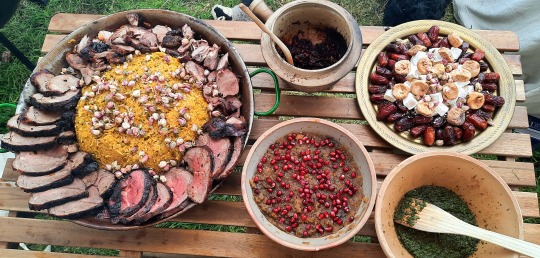
Food from one of the camp-cooked meals at Strawberry Raid 2022. Rice with peas and turmeric, surrounded by slices of spit-roast lamb and beef, and decorated with dried rosebuds. At the top, a sauce of pomegranates, raisins and spices, inspired by one in al-Warraq. Bottom centre, a turnip dish, also from al-Warraq, garnished with pomegranate seeds. Bottom right, a green sauce, again from al-Warraq, and very similar to European ones. And at top right a dessert plate of dates, lokum and dried figs.
#camp cooking#sca#strawberry raid#kitchenwizard#commonplace#kitchen#outdoors#medieval#al-warraq#arabic food#historical cookery#food history#experimental archaeology
41 notes
·
View notes
Note
I realise you're HE, but any thoughts on how high school level education should be run/changed/etc? I'd love to know your views!
Oh sure, plenty, but they're not particularly informed lol
Well; Wales is actually massively and fundamentally changing secondary education atm, but we won't be getting students from it until the year after next, I think, so no real comment on effectiveness yet - but it's very interesting. They're getting rid of isolated subjects in favour of broad umbrella areas, as I understand it? So there's now Science and Technology (Physics, Biology, Chemistry, Computing, and all the various DT subjects like Woodwork, Electronics, Cookery, etc), Maths and Numeracy, Humanities (History, Geography, Ethics, Religion), Languages Literacy and Communication, and Health and Wellbeing (actually maybe Cookery comes under this one now? Dunno.) And there's a sixth to do with arts but I can't remember what it's called. But it includes Art, Drama, Media Studies, etc.
And then the idea is that a class will learn about a given topic at a time (I don't know for how long, so let's say six weeks), and this will be taught in each of those six umbrellas but via their own methods. So like... I dunno, let's say the Tudors:
That's fairly straightforward for Humanities, but in addition to giving you the historical facts you'd also explore historic trade routes and natural resources of the time and how they related to the politics (geography), the religious make up of the country and how THAT related to the politics (religion), etc.
Maths and Numeracy might explore how to use statistics to analyse Tudor era population or trade data.
Science and Tech could look at disease outbreaks and virology, or technological advancements and how they worked and get students to build one, or get students to construct a Tudor-era town using computer software
Languages can study plays from the era (Shakespeare), look at linguistic development, or use historical events as talking points to practice using vocab in conversations
Health and Wellbeing can explore stressors and challenges of the average Medieval peasant and how they overcame them, or play some popular Tudor sport or game, or make food to Tudor recipes, etc
The Arts one (god I cannot remember the name) can look at art history of the period, fashions, perform plays, etc
So everyone is still teaching the skills and knowledge of their subject areas, they're just united by one big case study. It apparently allows for far more integrated teaching, too, where two previously discrete subjects can join forces on a project.
All of which seems pretty good, on the whole, but also rife with issues if everyone isn't careful, so we'll see how it shakes out over the next few years.
From my own experiences of school though. Jesus. Something definitely needed to happen, fuck me.
What I should have learned in Textiles:
How to use a sewing machine
How to sew by hand to mend a tear
How to darn a hole
How to hem, dart, take in, and let out clothes
How to sew from a pattern
What I actually learned in Textiles:
How to use a sewing machine on its most basic setting
How to phone in creating a hand puppet out of felt because gluing was easier than sewing
How to badly sew an extremely makeshift and shit bag out of scrap fabric that you in no way want to then use
How to lose all interest in Textiles because it was useless and uninteresting
Like that is a VITAL skillset-imparting subject, and they fucked it, lads, they completely fucked it. Why did they never set us the task of buying a cheap shirt from a charity shop that we then amended in class? That would have been so useful.
Games and PE! Fucking hell! Here's what I should have learned:
How to stretch my body safely to target specific muscle groups, and in particular, how to cultivate a daily stretching routine I enjoyed and wanted to do
How to find a physical activity active enough to get me out of breath that I genuinely enjoyed, so that I wanted to continue it, e.g. salsa dancing or rope climbing or ice skating or hill climbing or assault courses or fucking anything at all
How to build my body up to doing particular activities safely and sustainably
How to find a physical activity to do on wet, cold, rainy days that would still be fun and I would still enjoy
Here's what I actually learned:
Physical activity is always uncomfortable and miserable and sometimes even painful
If you aren't enjoying running around in the wind and rain instead of the indoor gym The Problem Is You. Start Enjoying It.
Wanting to stay warm and dry and comfortable is a punishable choice.
You are only permitted to do physical activity in clothes that make you feel profoundly exposed and uncomfortable (a gym skirt and gym knickers in my school. Cycling shorts got you detention. Don't get me started on jogging bottoms.) Again, if you do not enjoy this, The Problem Is You. Start Enjoying It.
There are only three activity options. If you don't enjoy any of them, physical activity is not for you.
You should be able to Just Do physical exercise, without any training to build you up to it. If you can't and it hurts, this is because you're Bad At PE.
You will only be shown Once
Physical activity is only ever a team sport that you aren't good enough to be willingly picked for
LIKE WHAT THE FUCK
And you know what, LET'S round off with Food Technology/Cookery. Because I remember the things I was asked to make in FT. As a little baby Year 7, I still vividly remember two of the things we made.
Angel Delight. Easy, you might say! A simple treat, you might think! Easing the children into food prep, I hear you cry! But no, because the theme of the year was healthy eating, and so we were to add fruit to our Angel Delight. Any flavour Angel Delight, any fruit. Off you go.
I don't know if any of you have encountered fruit, Tumblrs, but it famously has faintly acidic juice. This will prevent the Angel Delight from setting within the one hour lesson, no matter how well you mixed the pudding, or how quickly you got it into the fridge. It will result in soggy gross lumps of oxidising fruit in sloppy liquid pudding.
Lesson learned: fruit makes food worse.
Cake. Easyish, you might say! A little harder than the Angel Delight but good training, you might think! A fairly straightforward process with a child-friendly food at the end, I hear you cry! But no, because the theme of the year was still healthy eating, so the teachers made it into an experiment; make four small cakes. One with sugar, one with sweetener, one with apple, and one with carrot. Then taste them and rank them in order. Off you go.
I don't know if any of you have ever tried eating sugarless carrot cake, Tumblrs, but I have, and I can tell you categorically that it really puts the "Did you know" into the phrase "Did you know that fructose and sucrose are not actually equivalents of each other in a culinary setting?" It was rancid. It was disgusting. It was vile. It made me hate carrot cake for the next 12 years, in case my mouth had to go through that ordeal again. I'm still highly suspicious of the stuff even now. To (I assume) the surprise of fuck-damned no one, we unanimously put them in the order of sugar, sweetener, apple, carrot.
Lesson learned: FRUIT MAKES FOOD WORSE AND CARROTS ARE ACTIVELY DISGUSTING
What possessed them?! No idea. Fucking hell.
Anyway this is getting long and I am still ill-informed. Peace out.
240 notes
·
View notes
Text
Christmas pudding [...] [is] a boiled mass of suet - a raw, hard animal fat [...] often replaced with a vegetarian alternative - as well as flour and dried fruits that is often soaked in alcohol and set alight. [...] [I]t is a legacy of the British Empire with ingredients from around the globe it once dominated [...].
Christmas pudding is a relatively recent concoction of two older, at least medieval, dishes. [...] “Figgy pudding,” immortalized in the “We Wish You a Merry Christmas” carol, appeared in the written record by the 14th century. [...] During the 18th century, the two ["plum pottage" and "figgy pudding"] crossed to become the more familiar plum pudding – a steamed pudding packed with the ingredients of the rapidly growing British Empire of rule and trade. The key was less a new form of cookery than the availability of once-luxury ingredients, including French brandy, raisins from the Mediterranean, and citrus from the Caribbean.
Few things had become more affordable than cane sugar which, owing to the labors of millions of enslaved Africans, could be found in the poorest and remotest of British households by mid-century. Cheap sugar, combined with wider availability of other sweet ingredients like citrus and dried fruits, made plum pudding an iconically British celebratory treat, albeit not yet exclusively associated with Christmas.
Such was its popularity that English satirist James Gillray made it the centerpiece of one of his famous cartoons, depicting Napoleon Bonaparte and the British prime minister carving the world in pudding form.

In line with other modern Christmas celebrations, the Victorians took the plum pudding and redefined it [...], making it the “Christmas pudding.” In his 1843 internationally celebrated “A Christmas Carol,” Charles Dickens venerated the dish as the idealized center of any family’s Christmas feast [...].
Three years later, Queen Victoria’s chef published her favored recipe, making Christmas pudding, like the Christmas tree, the aspiration of families across Britain.
Christmas pudding owed much of its lasting appeal to its socioeconomic accessibility. Victoria’s recipe, which became a classic, included candied citrus peel, nutmeg, cinnamon, lemons, cloves, brandy and a small mountain of raisins and currants – all affordable treats for the middle class. Those with less means could either opt for lesser amounts or substitutions [...]. Eliza Acton, a leading cookbook author of the day who helped to rebrand plum pudding as Christmas pudding, offered a particularly frugal recipe that relied on potatoes and carrots. [...] The high alcohol content gave the puddings a shelf life of a year or more, allowing them to be sent even to the empire’s frontiers during Victoria’s reign [...].
---
In the 1920s, the British Women’s Patriotic League heavily promoted it – calling it “Empire Pudding” in a global marketing campaign. They praised it as emblem of the empire that should be made from the ingredients of Britain’s colonies and possessions: dried fruits from Australia and South Africa, cinnamon from Ceylon, spices from India and Jamaican rum in place of French brandy.
Press coverage of London’s 1926 Empire Day celebrations featured the empire’s representatives pouring the ingredients into a ceremonial mixing bowl and collectively stirring it.
The following year, the Empire Marketing Board received King George V’s permission to promote the royal recipe, which had all the appropriate empire-sourced ingredients. Such promotional recipes and the mass production of puddings from iconic grocery stores like [Sains-bury's] in the 1920s combined to place Christmas puddings on the tables [...].
---
All text above by: Troy Bickham. "How the Christmas pudding, with ingredients taken from the colonies, became an iconic British food." The Conversation. 8 December 2023. [Bold emphasis and some paragraph breaks/contractions added by me. Image and caption shown unaltered as they appear published by Bickham along with the article's text.]
55 notes
·
View notes
Video
youtube
Here’s a dish from French Cooking Academy, another of my subscribed YouTube channels.
I like the business of stuffing each chunk of beef with a bit of garlic and bacon; I’ve done this with lamb, using garlic and lemon. Another interesting detail is the use of cinnamon, suggesting a way-back-when influence either from the Moors or having access to spices as they passed through from Dpain Spain or North Africa on the way to somewhere else.
Kokkinisto (Greek) and Tajine (Morocco) also use cinnamon - and cloves, and nutmeg, and ginger etc. etc. depending on recipe. I’ve made both, they’re really excellent.
@dduane and I got Very Interested because the use of what Mum used to call “cake spices” is also quite medieval and, in DD’s case, adaptable for the Middle Kingdoms project.
The Corsican one recommends rigatoni, cannelloni or similar large hollow pasta (presumably to hold lots of sauce!) For a more medieval approach I’d try Loseyns from late-1300s cookbook “The Forme of Cury” (that’s “cookery” without the k, so “coo’rey” not “curry”.)
*****
These are often regarded as Richard II-era ”lasagne”, though I wonder if there’s also an association with heraldic “lozenges”, easily created by cutting a sheet of pasta dough slantwise...

Either way, here’s “Tasting History with Max Miller” (subscribed of course!) having a go at Loseyns, which turn out like mac & cheese with extra spices.

Max ended up eating them with a stick because forks hadn’t been introduced yet, but IMO a better utensil would be the historical eating pick, like one of these.

...or even a spoon, especially if the loseyns were cut small with that in mind.
However eating pasta with the fingers - like many other foods - may have been done in the 1300s; it was certainly recorded in paintings from the 1600s...

...right up to the 1800s...
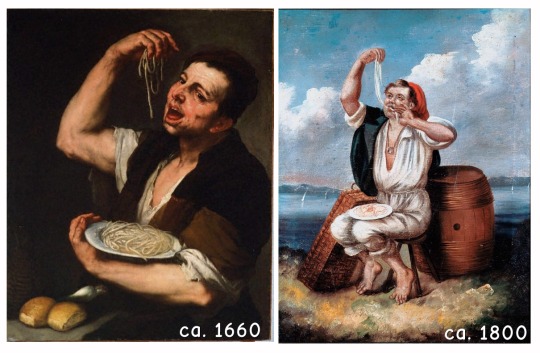
...though I don’t think these were dressed with anything more than oil or butter and some grated cheese, and the potential for messy eating was still pretty high. Eating small pasta rather than dangly strands with the fingers was probably much tidier, especially if diners knew the proper etiquette for doing it...
Finally, here’s something from our own store-cupboard, bought out of curiosity during a recent visit to Polonez in Dublin.

This is pasta cut into little squares; both the front and the back of the pack calls them łazanka...
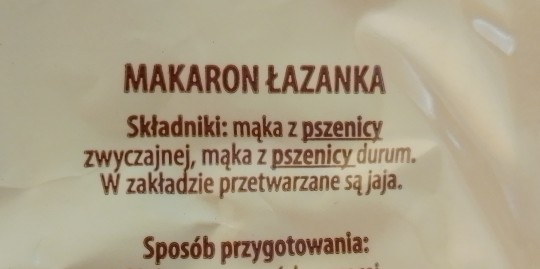
...and according to Google Translate, this just means “pasta noodles”.
However...
Can any followers tell me if "łazanka” has any relationship to “lasagna” or “lozenge”? An enquiring mind wants to know! :->
ETA: @seriously-mike says “...łazanki were brought to Poland in 16th century by queen Bona Sforza (so) the relationship with lasagna might be there.” See his Reply for more info.
ETA (2): A little bell went off in my head about the shapes in the bag and I suddenly remembered seeing them as something call “torn pasta” - the Italian word is “maltagliati“ - which were made using re-rolled scraps of dough from “formal” shapes; more info at that link.
#food and drink#corsican beef ragout#spices in cooking#medieval cooking#food and cooking of the middle kingdoms#French Cooking Academy#Tasting History#lasagne#pasta
154 notes
·
View notes
Text
Increasingly confident that the Sui siblings are being themed around the classical ideas of the fine arts and mechanical arts - if only because metalworking, painting, poetry, martial arts, and cooking fit into few other collective bins. Most listings of "the arts" cover only the middle two, and the only Chinese equivalent I'm aware of only counts four - nowhere near the twelve we'd need for the siblings.
One of Arknights' big Things is the artificial foundation of civilisation, and the Sui seem pretty closely tied to that in the form of taking Yan from the unified Feranmut, who are cast as being a sort of rampaging nature spirit; but there's not many lists of "things that define civilisation" that puts poetry and blacksmithing on the same level.
Right now, we know the general domain of a few of the siblings:
Nian and metalworking
Dusk and painting
Ling and poetry
Chongyue and martial arts
"Youngest Brother" and cookery (Nian's voicelines)
An unnumbered brother and medicine (WB-8)
and can conjecture to a couple more:
Jie, the deceased one, is noted for her calligraphy, which is counted among the fine arts
Shu, namedropped in IW-9, written with the Chinese character for "millet"; probably relates to agriculture, as millet was the first staple grain in China
Dusk, Ling, and Jie are all associated with what are normally called "fine arts" - painting, poetry, prose/calligraphy. There's two more missing, sculpture and music, but we need seven more, and it needs to include metalworking, martial arts, cookery, and medicine.
Thankfully we have exactly such a list.
In pre-medieval and medieval Western education, "art" essentially meant "craft or skill" and didn't have the same cultural connotations today. These skills were divided into two major categories:
First there were the liberal arts, in this case meaning "the skills of a free citizen", considered to be essential for civic participation by members of the classical elite. These weren't "art" in the sense that we think of it today, but instead a sort of list of essential skills like logic and rhetoric. Most significantly, they were explicitly enumerated into a list of seven, divided into smaller lists of three and four, and if there is one thing you should know about the European scholastic tradition, it's that it's extremely horny for the number seven.
Alongside the liberal arts were the mechanical arts, which much like "liberal" had a very different meaning - "mechanic" meant "a labourer, someone who uses tools", so "mechanical arts" meant "skills of a labourer". They were also called the vulgar arts which meant basically the same thing at the time but has taken a very different linguistic journey. Originally, the term just referred to any skill that wasn't one of the seven liberal arts, but because European scholasticism is extremely horny for sevens, people decided to try and group it into a single list of seven explicit things. A reasonably consistent listing of the seven would be
clothesmaking (including weaving and leatherworking)
agriculture
architecture (including masonry and carpentry)
martial arts (including hunting)
trade (including navigation)
cooking (including medicine)
metalworking (including metallurgy)
Now, this list isn't completely comprehensive. Trade is dropped from a lot of lists as it is not "mechanical", but included in enough of them that I have it here; one list might combine things in a different way, or separate out the things I have combined above. Shout out in particular to Hugh of St. Victor, who is so horny to have exactly seven things that his list - weaving, armament, commerce, agriculture, hunting, medicine, and acting - classifies carpentry and masonry under "armament". Most of the lists just kick pottery under agriculture like a cartoon character hiding something twice their height under a thin blanket.
(As an aside, this division into liberal and mechanical arts is largely responsible for the reputation of medieval Europe as a technological dead end, the so-called "Dark Ages" - not because there weren't developments in the mechanical arts, but because the scholastic establishment of the time didn't think such things were worth writing down! Augustine of Hippo, for instance, called the mechanical arts "pagan teachings" among which "[he] found nothing of use".)
But to loop things back around to the Arknights analysis, it definitely accounts for Nian, Chongyue, and the Youngest Brother - the Sui who fit generally recognised "art forms" least. It also includes Shu, if his power is agriculture as conjectured.
Now, the biggest conjecture I've made here is that the younger brother Chongyue mentions as a healer is also the one Nian mentions as a cook - which I think is entirely reasonable, given the interrelated nature of cooking and folk medicine - but that's mostly down to making it fit my listing of the seven artes mechanicae - it's entirely possible (and downright likely, really) that if they're actually looking at a list of them to round out the squad, they're using one that counts cookery and medicine separately.
(If I had to guess one that they're omitting, it'd be trade - it's something of an odd one out, as all the others are generative. Though my guess at the moment is trade is associated with the Second Brother, who so far has only really shown the ability to learn the skills of others rather than generate anything of his own.)
#arknights#long post /#the artes mechanicae is also why we have the term 'arts and crafts'#(it's crafts)
56 notes
·
View notes
Text
“The swan was too rich for his taste.”
Re @jaydeewis's gorgeous artwork illustrating a meal from Tyrion XII, ACOK, @daenerysoftarth wanted to know why the roast swan appeared to be unplucked.
And that's actually one of the more interesting details found in some medieval feasts! The nobles were showing off their wealth by the way they served their food-- and one of those ways was to display meats and poultry as the animals appeared in life. You see this in the classic "whole roast pig with an apple in its mouth", but it was also frequently done with fancy fowl like peacock and swan. (Birds no peasant could ever eat-- hunting swans, for example, was poaching, a criminal activity, as even wild ones belonged to the crown.)
And so GRRM has this in ASOIAF, often referring to "peacocks served in their plumage" and similar. But how was this done? Well, it was really almost taxidermy. After the bird was slaughtered, the skin was carefully removed with the feathers intact, the flesh would be roasted, and then they would put the skin back on. (Sometimes with a prop to keep the neck straight, or for the peacock tail.) Yes, putting uncooked skin on cooked meat is terrible re food safety, and, well, this is why you hear about medieval people dying from indigestion. (But what health problems didn't they have.) Still, they were so careful with the process that the display method was called "a subtlety".
Although sometimes they had a little more care re food safety, and would make the peacock or swan meat into a pie, and attach the neck/wings/tail to the pie crust. There's actually a fascinating pair of paintings from the 1600s, after the turkey was introduced to Europe (as part of the Columbian exchange, and the topic of how a New World bird ended up being called "turkey" or "india chicken" in many languages is also fascinating but not the point right now), that shows two different but almost identically presented feast tables, one with a peacock pie and the other with a turkey pie, both "served in plumage":

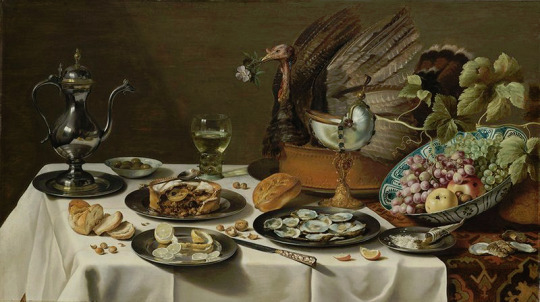
(both paintings by Pieter Claesz, 1627)
If you're interested in the subject, here's a few sources:
The Inn at the Crossroads, my favorite blog for ASOIAF food (and note if you like swans but don't want to eat a real bird, their cream swans are a delight. Also their recipe book is *chef's kiss*, literally.)
Foods of England
Historic Cookery
Coquinaria
Folger Shakespeare Library
And for more food, my asoiaf food tag has various artworks and metas and recipes. Enjoy!
#asoiaf#asoiaf meta#asoiaf food#valyrianscrolls#medieval history#poultry#swans#peacocks#turkeys#food#food tw
85 notes
·
View notes
Photo
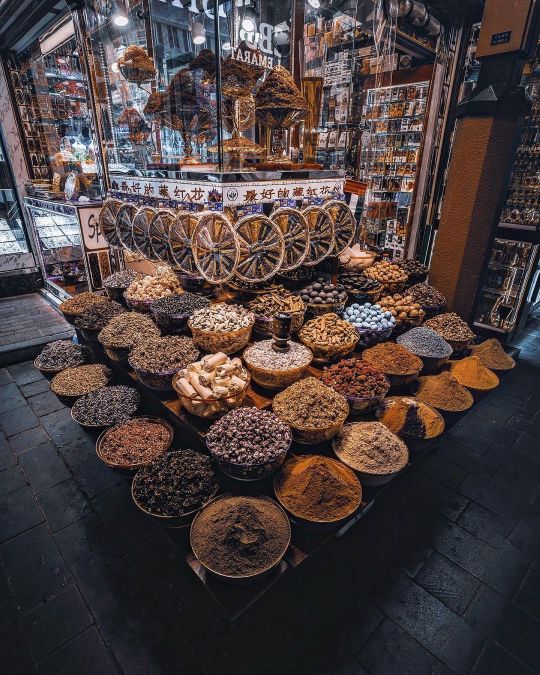
Cookery means…English thoroughness, French art, and Arabian hospitality; it means the knowledge of all fruits and herbs and balms and spices; it means carefulness, inventiveness, and watchfulness...It means, in fine, that you are to see imperatively that everyone has something nice to eat.
- John Ruskin
The history of spice is almost as old as human civilisation. It is a history of lands discovered, empires built and brought down, wars won and lost, treaties signed and flouted, flavours sought and offered, and the rise and fall of different religious practices and beliefs. Spices were among the most valuable items of trade in ancient and medieval times.
As long ago as 3500 BC the ancient Egyptians were using various spices for flavouring food, in cosmetics, and for embalming their dead. The use of spices spread through the Middle East to the eastern Mediterranean and Europe. Spices from China, Indonesia, India, and Ceylon (now Sri Lanka) were originally transported overland by donkey or camel caravans. For almost 5000 years, Arab middlemen controlled the spice trade, until European explorers discovered a sea route to India and other spice producing countries in the East.
A walk through the old souk or as its called the spice souk in Deira, a much older part of Dubai than the shinier futuristic side, is something I would recommend to anyone coming to Dubai. If you want history, you won’t see it in modern Dubai which is in a hurry to build the future. But come to the spice souk, and haggle and have some chai, and you can smell the history of the old Arab spice trade.
For a gourmand like myself who loves to cook with spices, this is a taste of heaven.
#ruskin#john ruskin#quote#spice#spice souk#souk#dubai#spice trade#history#cooking#cuisine#gourmand#deira#personal
93 notes
·
View notes
Text
Dragon Age Fanfic Fun, Part 1: Cook Shops
Edit: I realized, oddly enough, that I wrote this with Haven and Skyhold in mind (in short, DAI - probably because that's what I've been replaying as of late, lmao.) I promise I will get around to including how cook shops would operate in places like Kirkwall or Denerim (basically, urban centers)!
This will be part one of a series that was inspired by this video by the Modern Knight, in which I come up with silly little immersive ideas that one can easily add to their Dragon Age fanfic (or perhaps any medieval-themed fic/story) with the Dragon Age/Thedas setting in mind.
I hope to maybe do a series on this, at the very least for my benefit to reference instead of getting lost and forgotten about in a notebook, lmao. So let's begin, below the cut!
Also mild disclaimer, this is not an end-all-be-all where "OMG WHAT IF THIS ISN'T REALISTIC ENOUGH??" or "ACKTUALLY, MEDIEVAL FOOD SELLERS WOULDn't..." - look, at the end of the day this is just fanfic fodder for you and your blorbos, not a history lesson. I'm bound to make an error in judgment or descriptions, don't come at me with pitchforks. 😔
So you're hanging out in Haven or Skyhold. You're building up the Inquisition from the ground up with allies and defense forces - but also the little people to sell their wares (like our favorite Orlesian merchant, Miss Belle), but what about... Food!? Who's feeding everyone!?
Cook shops!
Or, "medieval fast food." These cook shops would be strategically placed where there would be frequent passers-by, such as next to a market square, or a busy gate entrance, and cooked to eat on the go (rather than cook-to-order.) In short, you see a tasty-ass pie, you buy it, and eat it right then and there.
I can also imagine the types of clientele our varied cook shops might have; you have a wide range of people (and pockets), varying from Templars with their income, refugees who may only be able to afford suspicious cuts of meat, or members of the Chantry with specific food preferences.
What sort of food would a cook shop sell?
This is not an exhaustive list of foods a cook shop would sell in Thedas, but perhaps ideas/suggestions you can quickly use. Otherwise, I'd recommend checking out @exhausted-archivist (formally known as @old-archivist) who will easily have a vast list of Thedosian cookery that will tickle your fancy in their Foods of Thedas Masterpost (it will even specify the region in which certain meals come from!)
Also since Haven and Skyhold are Ferelden-based, keep in mind what types of foods/ingredients will be procured/used in the food being sold. There are of course exceptions, such as Belle who was recruited from Orlais, for example (so there is always the possibility of foods outside of Ferelden cuisine.)
Also, cook shops can serve a specific type of food (rather than being a mobile Walmart of sorts.) Personally, I'd be a fan of Pickled Food Merchant... mmm. Pickles.
Boiled roots
Meat/Fish/Vegetable pies
Porridge
Roasts
Sandwiches
Sausages
Fish wraps
Soups/Stews
Nuts
Dried/Cured fruits or meats
Pickled foods
Hardtack
Rations
Edible plants
Desserts
Cheaper cuts of meat
Fried/Buttered foods
There are also ideas from other historical/modern use of foods:
Perpetual stew
Pagpag (though I see this used in more urban areas, such as Kirkwall's Lowtown)
But what about breads and drinks!?
Typically you would go to a baker for breads, or the tavern for drinks. In short, if you wanted to conjure up a meal, you'd have to likely go to different locales/merchants to pick and choose your foods. I feel like maybe bread could be an exception, since I can't imagine a baker really setting up shop in Haven/Skyhold because, well, baking, but this is all fantasy so you know what, fuck it, add your traveling baker!
Alcoholic drinks, of course, would be reserved for taverns. When it comes to non-alcoholic beverages, I'd still suggest sticking with taverns because they have the facilities for storage (casks, wells, tubs, etc.) But, again, have your own traveling wine seller, you do you boo.
Honestly, I like to imagine Haven or Skyhold being way bigger than portrayed in the game, so perhaps there would be room for a complete bakery (I mean, we've got Herald's Rest in Skyhold, so why not?)
Just, uhhhh, I feel bad for those merchants at Haven. Because, you know. Reasons.
What would a cook shop look like?
Since I imagine a cook shop for organizational establishments like the Inquisition, you won't exactly have people selling food right out of their homes (as was done in medieval times), since Haven or Skyhold aren't exactly "towns."
Instead, temporary stalls, huts, or cabins could be used to open and close up (in short, you won't be finding any glass windows or bars to protect products. Rather, there would be a shutter or board of sorts, that goes over the gap where you see the person cooking, which would be lowered during the day (like a table to display food) and then shut up and bolted when closed. The "ovens, and cooking facilities" are placed at the front so you can see the chef cooking, just like at Subway when you watch people make your little dinky sandwich.
Another alternative, you could simply have someone wandering about with a tray of foods they want to sell and yelling at the people of Haven/Skyhold to eat it (think popcorn, and hot dog sellers at baseball games. :)
When vendors sell their food, they may also yell at passersby to eat their products at certain times of the day
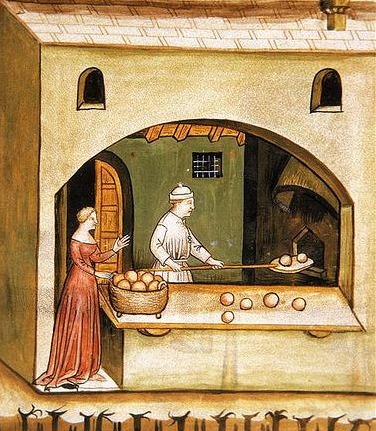
Services
Now this is gonna be fun. You can also have a cook shop that will literally make the food for you if you provide the ingredients (obviously if the merchant has the capability/equipment to do so.) In this case, according to the Modern Knight, ingredients would likely be made into pies or stews (be wary though, as merchants might steal some of the ingredients for themselves. 👀)
Also, how does Haven/Skyhold manage to look so nice when there's waste to be had? There were cesspits or barrels used to take away waste off-site. Also, be wary of hygiene practices; especially when it comes to using spices to cover the taste/look of spoiled food!
Sus Cook Shops
I'll just leave this here, for signs that a cook shop is rather questionable:
Flies
Reheated meats/foods
Foul garnishes
Faking the contents of food (such as using beef and promoting it as venison)
Well, there you have it. A basic gist of cook shops and fast food that you can implement into your DA fic (and maybe even conjure up some OCs!) Feel free to include in the comments/reblogs any other ideas you might have! Thanks for reading!
10 notes
·
View notes
Text
These local pamphlets and small books of recipes, brought out to raise money by schools, monasteries, the Women’s Institutes, often contain a handful of regional recipes that have been popular for centuries, although they have never quite reached the main cookery books. Often, one hears an echo of some medieval or Tudor dish, undimmed by additions of baking powder, or the substitution of margarine and vegetable fats for butter and lard.
3 notes
·
View notes
Text
Cooking in Stoneware Pots
For my elevation, Órlaith and Gytha got me a stoneware cooking pot. This is a pot made of actual stone - soapstone - and of a kind widely used in the Middle East in the era in which al-Warraq was writing. I have finally gotten a chance to try it out, since Pen & Sword provided me with an event where I had room on the fire and wasn't under any pressure to produce food (I was cooking a couple of Arabic stews, but they're things I know well).
The most immediate thing, which is completely obvious once it's pointed out, but which I didn't know before, is that a thick stone pot (the walls are not quite an inch thick) retains far more heat than a cast iron pot, which retains a good bit more heat itself than a stainless steel one. Nonetheless, if you take a cast iron pot off the heat, it will stop boiling in seconds. The stoneware one just keeps on boiling, and will do so for a good 2-3 minutes.
This makes sense of a number of instructions in period texts where pots are removed from the heat, and also makes sense in the context of serving the food in the cooking pot - the food will stay hot for much longer than it could in any serving dish. There's usually an instruction to wipe down the pot to remove soot and so on, so there's no doubt that it's the actual cooking pot.
Second, and this will need more trials, the food tasted different - the sweetness of the onions was far more evident. Also, there's a separation that happens when the stew is ready; you can see oil and other liquids apart from each other at the edges of the pot. This happened sooner, by far, in the stone pot. That might be because it's smaller, of course. Further experimentation needed.
#sca#medieval food#medieval cookery#medieval cooking#medieval arabic food#al warraq#soapstone#stoneware#more research necessary
22 notes
·
View notes
Text
Sweet Potato Pie

Below is an article about the dessert known as Sweet Potato Pie:
SWEET POTATO PIE
When it comes to holiday desserts - especially those for Halloween, Thanksgiving or Christmas, many people tend to bring up the old favorite, Pumpkin Pie. But there is another pie that is also popular in the United States. It is called the Sweet Potato Pie.
Creamy vegetable pies date as far back as the Medieval era in Europe. But like the Pumpkin Pie, Sweet Potato Pie can trace its origin to the early Colonial era, especially in the southern colonies. And like Pumpkin Pie, Sweet Potato Pie can be traced to Native American cuisine. The sweet potato - called a "yam" by some (although it is not one) - is native to the tropical regions of the Americas. Namely the Peruvian forests. Spanish traders who had arrived in Peru, eventually introduced the vegetable worldwide - especially in North America and Europe.
The sweet potato became very popular in Europe, especially in Britain. Cookbooks like 1747's "The Art of Cookery Made Plain and Easy" included recipes for tarts, other pastries and puddings that utilized sweet potatoes. The vegetable eventually attracted the attention of wealthy Southern plantation owners and eventually tasked their enslaved cooks to prepare or create sweet potato dishes.
Originally, the African or African-American slaves were accustomed to the textures and flavors of their native West African root tubers such as the starchy yam and cassava. They did not immediately embrace the sweet potato when it was first introduced. In the end, they regarded the sweet potato as a substitute for the yam and like their enslavers, embraced it. One of the dishes created by enslaved cooks during the Colonial period proved to be the Sweet Potato Pie. This especially tend to be the case in the American South. Since pumpkins grew in abundance in the Northeastern colonies - later states - the Sweet Potato Pie had never reached the same level of popularity in that region, like it did in the South.
Sweet Potato Pie was basically prepared as a dessert in an open pie shell. Its filling consisted of mashed sweet potatoes, evaporated milk, sugar, nutmeg, cinnamon, nutmeg and eggs. Alternate ingredients include vanilla or lemon extract. The custard filling may vary from light to dense, depending on the recipe's ratio of sweet potato, milk and eggs. As I had hinted earlier, Southerners and African-Americans specifically, usually ate Sweet Potato Pies during the American holiday season, especially on Thanksgiving and Christmas, as a dessert.
Below is a recipe for "Sweet Potato Pie" from Rosie Mayes' I Heart Recipes website:
"Sweet Potato Pie"
Ingredients:
Pie Crust
*Cold butter and butter-flavored shortening
*Cold water
*All-purpose flour
*Salt
*Vanilla extract
*White granulated sugar
(Note: You can also purchase a ready-made pie crust as a substitute)
Pie Filling
*Sweet potatoes or yams
*Evaporated milk or half-and-half milk
*Vanilla extract or Bourbon Vanilla extract
*Cinnamon
*Nutmeg
*Ginger or lemon extract
* Hand-crafted yams spice mix from Rosamae Seasonings
*Two large eggs
*White granulated sugar
Preparation:
Pie Crust
*Combine flour, salt, sugar, vanilla, butter, butter-flavored shortening, and ice-cold water in a stand mixer.
*Mix until well combined into a dough.
*You’ll want to wrap the dough in plastic wrap and allow it to chill in the fridge until you’re ready to roll it out.
*You could also use a food processor to make the dough.
Pie Filling - Boil Sweet Potatoes
*Wash and peel the skins of the sweet potatoes and chop them up into about 1-inch cubes.
*Put the sweet potatoes in a pot with enough water to cover them completely (about 4-6 cups).
*Boil the sweet potatoes until they are fork-tender, about 15-20 minutes.
Pie Filling - Bake Sweet Potatoes
*Preheat your oven to 350 degrees Fahrenheit.
*Pierce the sweet potatoes with a fork, then place on a baking sheet and cook—with the skin on—until fork-tender. The time really depends on how big they are, but it should take about 35 minutes.
*Scoop out the insides of the sweet potatoes into a large bowl, and allow them to cool completely.
Preparation (continued)
*In a large bowl or stand mixer, whip the sweet potatoes until they’re fluffy and creamy—no lumps! You can either use a hand mixer (electric mixer) or the whisk attachment of your stand mixer.
*Next, add the rest of the sweet potato pie filling ingredients—eggs (make sure they’re at room temperature), sugar, spices, vanilla, evaporated milk, and butter (also at room temperature). Mix these ingredients until well combined. You want your pie filling to be almost fluffy—that gives this sweet potato pie its iconic texture.
*Next, roll out the cold pie dough. For best results, you should use a 9-inch pie plate. I do blind-bake my pie crust at 350 degrees for just 10 minutes before adding the filling.
*Finally, add the sweet potato pie filling. Smooth it in that crust, then bake for 45-50 minutes. It will look weird and puffy when it comes out but allow it to cool, and it’ll settle.
*Let the sweet potato pie cool for at least 30 minutes, up to 2-4 hours, until it’s at room temperature. This will allow the pie filling to set completely, so it’s the perfect fluffy texture.
#food#food history#history#medieval europe#spanish empire#british empire#colonial america#u.s. slavery#sweet potato pie#i heart recipes#rosie mayes#holidays#holiday cooking#thanksgiving#christmas
2 notes
·
View notes
Photo

Medieval food and cooking was always one my most popular demonstrations. It wasn’t just the food, it was the history and culture, in some instances, the legend through symbolising of food and drink that people commented positively about. Maybe you have an event where medieval cookery might be suitable in demonstration or in talk or lecture? Let me know! #medieval #middleages #food #feast #banquet #rations #dailybread #grace #dining #eating #drinking #foodies #foodandbeverage https://www.instagram.com/p/Choh12LBEZ6/?igshid=NGJjMDIxMWI=
#medieval#middleages#food#feast#banquet#rations#dailybread#grace#dining#eating#drinking#foodies#foodandbeverage
21 notes
·
View notes
Text
400 Years of French Gastronomy Books to Auction

Christie’s is inviting foodies and collectors to explore four centuries of gastronomy and its history through a selection of books from the library of Baron Pierre de Crombrugghe.
Cooking and the culinary arts have always been the subject of poems, treatises and educational works. But it was not until the 19th century that the concept of gastronomy emerged in earnest. The Baron's library displays a number of themes that are inextricably linked to the culinary experience and the way it has evolved throughout history. Its shelves provide a rich menu of treatises on how to cut meat, poultry and fish, as well as texts on truffles, oysters and baking.
There are also books explaining how to make iced desserts, tea, coffee and chocolate, and how to set the table and fold napkins. This collection of nearly 200 works is estimated at around €1,500,000.
The highlight of the library of Baron Pierre de Crombrugghe is the Cuisinier Taillevant, ou le Viandier, the first known illustrated cookery book. This rare incunabulum, written in French, was published in Lyon in around 1495. Decorated with a large woodcut depicting a cook at the stove and bearing the name of the head chef under Kings Charles V and VI of France, the Cuisinier Taillevant is the ultimate reference work on French medieval gastronomy. The volume for sale is the only surviving complete copy.
READ MORE
#booksellers#bibliophile#book collecting#antiquarian books#escoffier#gastronomy#culinary#chefs#christies#auctions#librarians#archives#rare books#book tumblr
4 notes
·
View notes
Text
@tanadrin mentioned "amber" isnt germanic, so i looked up the etymology, and
mid-14c., ambre grice "ambergris; perfume made from ambergris," from the phrase in Old French (13c.) and Medieval Latin, from Arabic 'anbar "ambergris, morbid secretion of sperm-whale intestines used in perfumes and cookery" (see ambergris), which was introduced in the West at the time of the Crusades. Arabic -nb- often is pronounced "-mb-."
In Europe, amber was extended to fossil resins from the Baltic (late 13c. in Anglo-Latin; c. 1400 in English), and this has become the main sense as the use of ambergris has waned. Perhaps the perceived connection is that both were found washed up on seashores. Or perhaps it is a different word entirely, of unknown origin. Formerly they were distinguished as white or yellow amber for the Baltic fossil resin and ambergris "gray amber;" French distinguished the two substances as ambre gris and ambre jaune.
i guess amber wasnt that common until the modern period? also, they dont seem like similar substances? i guess theyre both kind of waxy/resinous? idk, its very odd. anyway, this made me google baltic amber, and
The Baltic region is home to the largest known deposit of amber, called Baltic amber or succinite. It dates from 44 million years ago (during the Eocene epoch).[1] It has been estimated that these forests created more than 100,000 tons of amber.[2] Today, more than 90% of the world's amber comes from Kaliningrad Oblast of Russia. It is a major source of income for the region; the local Kaliningrad Amber Combine extracted 250 tonnes of it in 2014,[3] 400 tonnes in 2015.[4]
?!?! its not clear to me why theres such a ridiculous amount of amber here, its so common it washes up on the beach! it seems like the three major areas were on the coast at the time of formation (theres also significant deposits on the coast of japan). something about coastal conifers is really good for producing huge amounts of amber i guess, keeps them preserved or something. they were definitely massive forests but there have been massive forests like everywhere so that cant be enough. this source says
When resin is secreted, it’s not certain that it will be turned into amber. More often than not, it gets weathered away. First of all the resin needs to be chemically stable and not degrade over time. It has to be resistant to sun, rain, extreme temperatures, and microorganisms like bacteria and fungi. There are two types of resin produced by plants that can fossilize. Terpenoids are produced by gymnosperms (conifers) and angiosperms. They are composed of ring structures made from isoprene (C5H8) units. Phenolic resins are only produced by Angiosperms. An extinct type of trees called medullosans produced another unique type of resin.
The next factor is that the resin needs to be in the right conditions to fossilize. Young amber could be transported in seawater (it floats), and then buried under sediment to fossilize. In the Baltics, glaciers knocked down many trees and buried them, allowing them to fossilize. Wet clay and sand sediments preserve resin well because they don’t contain much oxygen and the sediments eventually transform into rocks. Intense pressure and temperatures cause the resin to become a solid orange gem. First molecular polymerization forms copal (young amber) and then the heat and pressure drive out terpenes and complete the amber transformation
so i guess its exactly like normal fossils, needs to be buried in sediment just right to preserve it, and forests+glaciers+coast isnt common enough in large enough quantities to cause other massive deposits? anyway, neat!
6 notes
·
View notes
Photo

That’s a Parsnip Pie. (@dduane’s own blogpost is here.)
She read a tweet about it that worked as a cooking prompt, leading to this Twitter thread.
The thread includes a link to this article, whose writer didn’t like it for various reasons including its appearance (pies with a lattice rather than a lid are apparently Just Not Right) and a recipe whose ingredients seem out of whack, with far too much lemon and not enough everything else except parsnip.
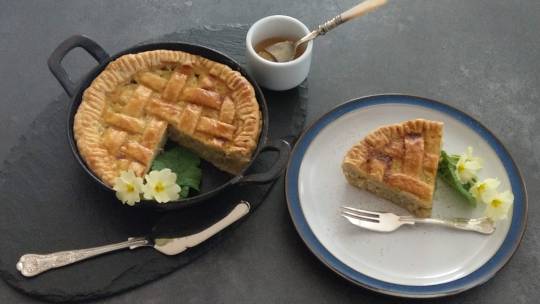
(I later found this article, whose writer seems much more in favour.)
Both articles make a comparison to pumpkin pie: a veggie-based egg custard with such a characteristic taste that “Pumpkin Spice” exists in its own right. However, pumpkin is much more bland than parsnip.
The “Food and Cooking of the Middle Kingdoms” project - set in a world where potatoes don’t exist and other roots take their place - has shown parsnips to have a noticeable pepperiness that’s easier to make use of than ignore.
It’s also easier to make use of in a savoury dish like “Coiner’s Bake” (adapted Pommes Dauphinoise) than in something sweet.
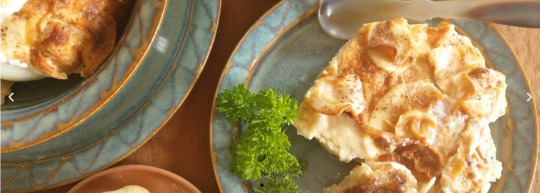
At least until DD made this pie.
All the details are in that Twitter link, but in short, rather than trying to hide the parsnip pepperiness, she worked with it by adding Long Pepper to the spice mix.
She also avoided excessive sourness by reducing the lemons from two to a half, then gave a different tang with grated root ginger not dry powder.
All this dialled the “taste” of the dish back from 1954 and past those Regency literary references of 1810. It’s now far closer to the flavours of medieval recipes we’ve made.
However, it’s not pumpkin pie, so it’s better not to make vague comparisons that might set up tastebuds for something they won’t get.
This is parsnip pie. And it’s good.

To our collective surprise, while we’ve got “English Food” (Jane Grigson), “The Cookery of England” (Elizabeth David) and ”Food and Drink in Britain” (C. Anne Wilson), we don’t have a copy of Dorothy Hartley’s book “Food in England”.
That’ll be put right ASAP.
89 notes
·
View notes